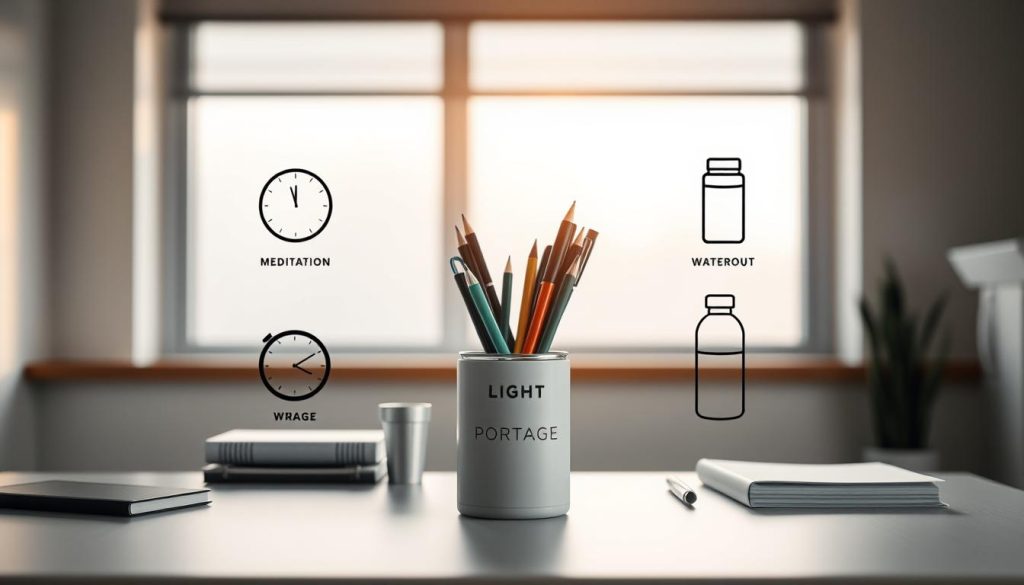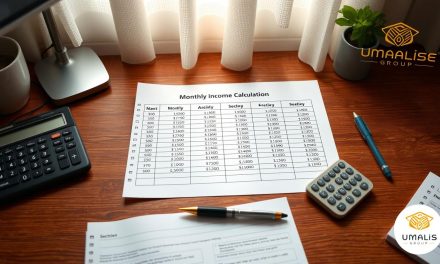We start with a short story: Claire, a freelance consultant in Lyon, woke one Monday feeling drained after a long weekend of client calls. She had met every deadline, but she could not muster focus. Her calendar was full, income varied, and she felt distant from the work she once loved.
This guide speaks to professionals like Claire who juggle delivery, client acquisition, and administration without an employer safety net.
The World Health Organization describes three core dimensions: extreme exhaustion, mental distance or cynicism, and reduced professional efficacy. In France, public estimates show the issue affects thousands and places millions at risk.
We offer a practical, protective approach. Expect clear steps to spot early signs, reduce chronic stress, and shape a sustainable rhythm for work and recovery.
For context and local resources, see our related piece on work-life balance in France: work-life balance and early signs.
Table of Contents
Key Takeaways
- Recognize the WHO’s three dimensions to spot warning signs early.
- Simple daily routines can cut risk and restore energy.
- Set realistic scopes and boundaries to protect focus and income flow.
- Use time-blocking and single-tasking to reduce overload.
- Seek professional support when red flags appear.
Understand Burnout Now: What It Is and Why Independents Are at Risk
When demanding work wears you down, it tends to show in three clear dimensions: energy loss, detachment, and reduced effectiveness. This is a work-related exhaustion of physical, emotional, and mental resources after prolonged effort in emotionally demanding roles.
WHO’s three dimensions help you name what you feel without self-blame.
Exhaustion, cynicism, reduced competence
Exhaustion means persistent tiredness that rest does not fully fix. Cynicism or mental distance shows as bluntness toward projects or clients. Reduced professional efficacy feels like slipping skills or lower confidence despite the same workload.
Independents face diffuse expectations, revenue pressure, and blurred hours. Those factors raise exposure to chronic stress and variable client situations.
- In France, roughly 30,000 people report full syndrome and about 3.2 million are at risk.
- This condition is work-related and distinct from clinical depression, though overlap can occur and medical assessment may be needed.
Understanding the frame lets you spot patterns early and make small, consistent changes to protect energy and professional standing.
Spot the Early Signs Before Fatigue Becomes a Freefall
Subtle shifts in how you feel and work are the earliest warning lights to watch. Noting small changes lets you act while performance and health are still intact.
Emotional, physical, and behavioral signals
Emotional: lower motivation, irritability, frustration, or distrust toward clients and projects.
Behavioral: more errors, missed deadlines, and longer effort for less output.
Physical: sleep disturbances, headaches or migraines, digestive troubles, tense muscles, or clenched teeth.
The typical progression
- Honeymoon: high energy and optimism.
- Onset of stress: small performance dips and mild fatigue.
- Chronic stress: recurring symptoms, sleep issues, growing errors.
- Severe stage: sustained functional decline and strong physical troubles.
- Chronic stage: long-term health and work disruption.
Practical step: keep a weekly log of symptoms, workload, and mood. Track rising error rates and longer task time as real signals to pause and reprioritize.
We also recommend this short guide on resilience and stress management for concrete tracking templates and early interventions.
Know Your Risk Factors in the French Work Context
Independent professionals face specific workplace risks that are shaped by client relationships and contract types.
French health authorities identify six work-related risk categories. We translate these into daily realities for independents: tight deadlines, vague briefs, shifting scope, and high emotional load from client work.
Work intensity, unclear goals, value conflicts, and insecurity
Intensity and poor organization show as repeated overload and unrealistic objectives. Autonomy may exist, yet client pressures can quickly erode decision latitude.
Weak or conflictual work relationships are reliable sources of cumulative strain. Value misalignment—doing projects that clash with your principles—drains motivation over time.
Personal amplifiers: perfectionism, isolation, and work-life conflicts
Personal traits can raise risk. Perfectionism, past depressive episodes, or social isolation make recovery harder.
- Audit your pipeline: unclear briefs and scope changes increase stress.
- Assess client relationships; recurring conflict is a key source of strain.
- Watch contract patterns: variable pay and delays create unstable situations.
« A short audit of tasks, clients, and values can reveal simple fixes that restore control. »
For a practical checklist on how work conditions map to independent practice, consult our work conditions overview.
Burnout prevention: Core Techniques Independents Can Apply Today

Small, practical adjustments to your week can sharply reduce overload and protect delivery quality.
Set clear weekly limits. Map obligations, then cap paid work—aim for ≤40 hours when you notice rising stress. Use that cap to say no or renegotiate before schedules expand.
Drop or delegate low-value tasks. Identify routine admin, repetitive updates, and low-impact meetings to outsource or eliminate. Protect your prime hours for high-impact client work.
Adopt a right-to-disconnect mindset
Define response windows and batch email checks. State service hours in proposals and contracts so clients know when you will respond. This limits surprises and reduces reactive work.
Practical daily habits
- Block deep-work slots on your calendar and protect them with holds.
- Communicate scope and capacity clearly to prevent last-minute expansions.
- Schedule a weekly review: what generated strain, what to stop, start, or continue—use data, not intentions.
Regular skill refresh raises efficiency so tasks take less time. For broader guidance on balancing work and life in France, see our work-life balance guide.
Redesign Your Workday to Lower Stress and Troubles
We recommend a clear structure that protects attention and reduces daily strain. A predictable plan limits context switching and helps you deliver with calm and accuracy.
Time-blocking and single-tasking
Time-blocking lets you reserve uninterrupted slots for deep work and add short buffers for meetings or emails. This reduces reactive work and lowers errors.
Replace multitasking with single-tasking. Break large projects into smaller, measurable steps with clear acceptance criteria.
Short breaks, mindful pauses, and recharge windows
Use 90–120 minute focus blocks followed by 5–10 minute breaks to keep concentration high. Move during breaks and take lunch away from screens to reset posture and attention.
Plan quarterly or annual recharge windows—several consecutive days to restore perspective and creativity. End each day with a short shutdown ritual to close loops and reduce evening rumination.
- Time-block with buffers to prevent context-switching that raises stress and errors.
- Decompose deliverables; scope realistically and avoid multitasking.
- Adopt short focus blocks and active breaks to reduce cognitive troubles.
- Schedule real lunch breaks and recurring recharge periods to sustain performance.
« A simple, repeatable rhythm of focused work and short recovery periods protects energy and improves outcomes. »
Self-Care That Sticks: Practical Techniques, Movement, and Yoga

Good self-care starts with small, reliable habits you can keep when workload peaks. We focus on simple, repeatable moves that stabilize energy and reduce daily fatigue.
Sleep, nutrition, hydration, and body scans
Prioritize consistent sleep (7–9 hours), balanced meals, and steady hydration to keep concentration steady. Small shifts in routine often yield quick gains.
Use a weekly body scan to detect tension early. Note tight areas, then respond with short stretches, posture resets, or rest before aches worsen.
Exercise: walking, gardening, and evidence-backed yoga
Choose accessible movement: brisk walks in green spaces or gardening for low-impact stamina and mood benefits. Both refresh the mind between client tasks.
Include gentle yoga as an option: research supports its role in managing work stress. Try brief sequences that open the chest and relieve neck tension.
Meditation and brief practices
Practice 2–10 minute mindfulness breaks to lower arousal and sharpen focus. Simple breath work, micro-stretches, or journaling are effective techniques you can repeat daily.
« Short, regular recovery moments protect energy and help you deliver with clarity. »
Boundaries and Support: Build Relationships That Buffer Stress
Clear boundaries and reliable support networks are the two strongest buffers against chronic work strain. They help you keep control of workload and protect your focus.
Say no with clarity by scripting polite, firm responses that protect scope and timelines. Set communication windows and define what counts as an emergency so exceptional situations do not become daily norms.
Say no with clarity; avoid toxic situations and media
We recommend brief templates you can reuse when declining new work or scope creep. State capacity, a brief reason, and an alternative if possible. This reduces reactive replies and ongoing stress.
Adopt media hygiene: mute sources that trigger comparison or doomscrolling after work. Avoid people or feeds that regularly create friction. Small cuts in exposure lower daily strain fast.
Create a supportive network: peers, friends, family, community
Talk with trusted contacts about early warning signs and invite them to flag changes. A peer circle provides accountability, referrals, and practical help during spikes.
- Set escalation paths and emergency definitions with clients and collaborators.
- Build a small peer group for monthly check-ins and capacity swaps.
- Brief family or friends on signs to watch, so isolation fades.
| Action | What to say | Benefit |
|---|---|---|
| Polite refusal script | « I can’t take this on right now; I can refer you or propose a later date. » | Protects time and scope |
| Communication window | « I respond to emails 10:00–12:00 and 16:00–17:00. » | Reduces reactive work |
| Media hygiene | Mute feeds that trigger anxiety | Fewer evening troubles and better sleep |
For more on balancing work and life, see our short guide on work-life balance tips for a more fulfilled. A clear boundary plan plus steady social support will reduce pressure and help you stay effective.
From Strain to Recovery: A Guide to Professional Help and Sources
If simple coping fails and symptoms persist, it is time to seek professional guidance.
When to consult: persistent exhaustion despite rest, worsening physical symptoms (headaches, stomach issues), growing cognitive problems, or any signs of depression such as deep hopelessness or suicidal thoughts. These are clear red flags that need prompt medical attention.
Therapies and treatment options
Talk therapy (individual or group) helps you reframe workload narratives and process emotional load. A GP can assess if medication is appropriate to treat depressive episodes or severe anxiety.
Structured lifestyle changes also matter. Expect changes to sleep, work scope, and daily routines as part of recovery. Return-to-work plans often proceed in stages and need coordination between you, your clinician, and any occupational health advisors linked to clients.
| Sign | Recommended action | Who to contact |
|---|---|---|
| Persistent exhaustion | Medical assessment; document patterns | General practitioner, occupational health |
| Escalating physical symptoms | Rule out medical causes; start therapeutic support | GP, specialist, psychologist |
| Depressive signs | Immediate clinical care; safety plan | GP, psychiatrist, emergency services if needed |
| Work-related overload | Structured return plan; adjust scope | Psychologist, occupational advisor, client contact |
What to expect: recovery timelines vary. Some people improve in six weeks; others take six to nine months or longer. Progress is often gradual and requires sustained changes to work habits, sleep, and relationships.
Document triggers, relief patterns, and workload data to share with your care team. For a practical companion to clinical care, see our mental health guide, which complements medical support and helps you plan a steady return to work.
Conclusion
Close your workweek with a short roadmap that keeps your energy and business steady.
Clarify scope, cap your billable hours, protect short breaks, and prioritise sleep to keep stress within a manageable range. These small rules preserve focus and quality.
Set clear boundaries with clients and lean on a trusted network to catch overload before it escalates. For help expanding your circle, consider exploring networking opportunities like this networking guide for independents.
Pick one change to start today — time-block next week or define response hours — and build momentum. Seeking early help is professional and speeds recovery. We stand ready with practical methods and steady support to protect your independent career.
FAQ
What exactly is professional exhaustion and how does it differ from ordinary stress?
Professional exhaustion is a sustained state of physical and emotional depletion linked to work. Unlike brief stress from deadlines, it affects three core areas — overwhelming fatigue, growing cynicism about work, and a fall in perceived competence — leading to impaired function over time.
Why are independent professionals particularly at risk in the French work context?
Independents face specific pressures: irregular income, role overload, unclear client expectations, and potential conflicts with personal values. These factors, combined with limited organizational support and social isolation, raise vulnerability to long-term strain.
What early signs should I watch for before fatigue becomes severe?
Look for emotional signs (irritability, detachment), physical signals (sleep issues, headaches, recurrent illness), and behavioral changes (missed deadlines, withdrawal from clients). Detecting these early lets you act before patterns become chronic.
How does the progression from initial stress to chronic crisis typically occur?
It often follows stages: an energetic “honeymoon” phase, onset of stress as demands rise, chronic stress with persistent symptoms, acute breakdown with significant dysfunction, and in some cases prolonged recovery if untreated. Each stage narrows your capacity to cope.
Which personal traits increase risk, and how can I manage them?
Perfectionism, excessive self-reliance, and poor work–life boundaries amplify risk. Manage these by setting realistic standards, delegating tasks, scheduling nonnegotiable breaks, and building a peer network for accountability and perspective.
What core techniques can I apply immediately to reduce risk?
Prioritize high-value work, cap weekly billable hours, eliminate low-return tasks, and adopt a firm right-to-disconnect approach for client communications. Small structural changes yield substantial relief when consistently applied.
How should I redesign my workday to lower stress and recurring troubles?
Use time-blocking to protect deep work, practice single-tasking, scope projects conservatively, and include short mindful pauses every 60–90 minutes. Plan annual recharge windows to prevent gradual depletion.
What self-care practices have the strongest evidence for improving resilience?
Regular sleep, balanced nutrition, adequate hydration, and daily movement are foundational. Add body-scan exercises to detect tension, and maintain consistent routines to stabilize energy and mood.
Is yoga useful for professionals who sit most of the day? Which styles help most?
Yes. Gentle, evidence-backed styles such as Hatha or restorative yoga improve flexibility, reduce tension, and support breath awareness. Short, regular sessions (10–20 minutes) can be integrated between work blocks.
How can mindfulness or meditation reduce anxiety and improve focus at work?
Mindfulness trains attention and reduces ruminative thinking. Brief daily practices—focused breathing, short guided meditations, or mindful walks—lower physiological arousal and improve decision-making under pressure.
What practical steps help set boundaries with clients while preserving relationships?
Communicate clear scopes, work hours, and response-time expectations up front. Use templated agreements and assertive but polite language to say no or propose alternatives. Consistency reinforces professional norms and reduces conflict.
How do I build a support network that actually buffers stress?
Combine peer groups (industry cohorts, mastermind circles), trusted friends or family, and professional mentors. Schedule regular check-ins, share concrete challenges, and exchange practical solutions rather than only venting.
When should I seek professional help, and what options exist?
Consult a clinician if exhaustion persists beyond weeks, if you experience sleep disruption, physical symptoms, or signs of depression or anxiety. Options include psychotherapy (CBT, ACT), occupational health consultations, medication when indicated, and coordinated lifestyle interventions.
Are there reliable French or international resources for independents seeking support?
Yes. Look for occupational health services in France (médecine du travail), accredited mental-health professionals, professional federations that offer peer support, and evidence-based sources such as WHO guidelines and peer-reviewed journals for strategies and referrals.





